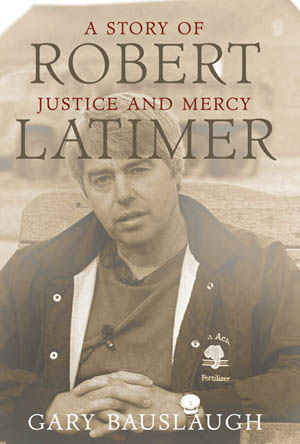
In 1993, Saskatchewan farmer Robert Latimer took the life of his cerebral palsy-striken daughter, Tracy, rather than force her to go through another painful, potentially futile operation. Author Gary Bauslaugh argues that Latimer might have broken the law, but that he is not a criminal.
Bauslaugh, a former president of the Humanist Association of Canada, argues Latimer’s conviction for murder, and his subsequent imprisonment, was a gross injustice against a man trying to ease his daughter’s suffering. Robert Latimer: A Story of Justice and Mercy does not pretend to be an impartial history of this emotionally charged case, but instead forcefully advocates that Latimer deserves the kind of mercy he felt he showed to his daughter.
My position going into this book was not wholly unsympathetic to Latimer, who went through 12 emotionally exhausting years caring for a seriously disabled young girl whose only means of communication was to cry out in pain. But he took that young girl’s life without her consent. Even if he genuinely believed Tracy was in so much pain she had to be put out of her misery, he could not know what she really wanted — or, indeed, whether she was capable of forming an opinion on the subject at all.
Therefore, I continue to have trouble with what Latimer did. And Bauslaugh, to his credit, agrees that the mercy killing of Tracy Latimer is troubling even for a supporter of euthanasia:
“I have no doubt, as I have indicated frequently in this book, that it was an act of mercy and compassion. . . . But for all of that, I cannot shake the feeling that he really ought not to have done it. It is a matter of relative harm. Tracy was undoubtedly better off dead, but she was likely to have died soon anyway. Latimer could not bear to see her continued suffering, but in ending Tracy’s life he seriously damaged his own life and that of his family. Was it worth it? It is impossible to say. I find myself both admiring his heroic act and questioning it, as well.”
Even if one accepts that Latimer was rightly found guilty of murder, however, there remains the question of whether he deserved to be treated like any other killer. The jury that found him guilty of murder did not think so: it voted to convict Latimer under the mistaken impression that he could be released after only one year in jail, because of the special circumstances of his case.
In fact, Latimer’s conviction of second-degree murder carried with it a minimum of 10 years’ imprisonment. And his initial appearance before the parole board resulted in Latimer remaining behind bars, despite posing no realistic threat to public safety, because of his apparent lack of remorse.
 Bauslaugh savages the Parole Board appointees who appeared to be making an example of Latimer, and also makes a convincing argument that jury nullification, though frowned upon by the Supreme Court of Canada, was an avenue that should have been open to Latimer and his legal counsel:
Bauslaugh savages the Parole Board appointees who appeared to be making an example of Latimer, and also makes a convincing argument that jury nullification, though frowned upon by the Supreme Court of Canada, was an avenue that should have been open to Latimer and his legal counsel:
“So it is not wrong for a jury to nullify the law, but it is wrong for a lawyer to counsel them to do so. Does that make any sense? A defence lawyer’s responsibility is to present the strongest possible case for acquittal of his or her client. Central to that case may be asking a jury to act according to its conscience. But according to the chief justice [Brian Dickson, in the 1988 R. v. Morgentaler decision] a defence lawyer cannot even allude to such a possibility.”
Latimer himself remains a somewhat enigmatic figure. Bauslaugh interviewed him several times, in and out of prison, but he reduced and ultimately ceased co-operating with the author when he discovered that a book was being written. Latimer has engaged in relatively little public activism for the right-to-die or euthanasia movements, and has not engaged with the many Canadians who believe he deserves clemency. (“He thinks it is an admission of guilt,” says Latimer’s sister, “and he believes he has nothing to feel guilty about; that he did the right thing.”)
Although Bauslaugh did not set out to write an unbiased history of the Latimer case, I do wish he had given his opponents’ arguments more credit. If he interviewed anyone who believed Latimer deserved his punishment, or any of the officials who contributed to what he believes to have been a grave injustice against Latimer, it is not evident from the final text, even in the chapter “Latimer’s critics.” Bauslaugh is an effective advocate for his position, but an actual engagement with Latimer’s detractors would have been even more compelling.
Still, Robert Latimer: A Story of Justice and Mercy, which was released earlier this month, is thought-provoking, and effectively raises issues that will have to be dealt with, once and for all, by the justice system. I still believe Latimer was rightfully found guilty of murder, but I don’t believe he should have been treated like just another murderer.
Damian J. Penny, a native of Mt. Pearl, N.L., is a family law practitioner with Bedford Law Inc. in Bedford, N.S. His blog can be found at damianpenny.com and his Twitter feed at twitter.com/damianpenny. He can be reached at [email protected]. His Law Library book reviews will be appearing bimonthly on canadianlawyermag.com.